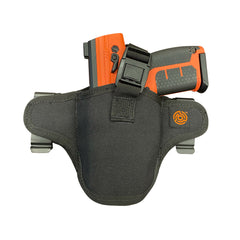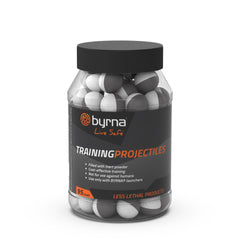
You board the bus after work, and there's a person in the back who's obviously having a rough time. Your hand automatically goes to your keychain, where you have that little canister of pepper spray attached. Then you wonder - can you actually have this item on the bus? The legality is something that commuters everywhere think about all the time. Many passengers want to have some protection when they're traveling, especially late at night or early in the morning. But they have no clue what the transit system actually lets them carry.
The policies are wildly different from one place to the next, and it all depends on the city you're in and which transit system you're riding. Something that's completely fine to carry as you're walking around downtown Chicago could get you arrested when you step onto a CTA train. You have federal regulations that overlap with state laws, and then each transit agency has its own set of policies on top of that. The whole situation creates this pretty confusing mess of restrictions that change from city to city. Sometimes, the different transit agencies in the exact same metropolitan area have very different policies on what you can and can't bring on board.
Most traditional self-defense tools are flat-out banned on public transportation systems nationwide. Getting caught with any of these means the police can arrest you, and prosecutors will follow through with the charges, too. What makes it worse is that the punishment is usually way harsher than if you'd had that same item while just walking on the sidewalk. Fortunately, you can find a few legal alternatives out there that can help to protect you during your everyday commute, and they won't land you in jail or drain your wallet with fines.
Here's what you can legally carry to stay safe on public transportation!
Table of Contents
Each Transit System Has Different Rules
Federal laws are just the first layer of requirements you have to worry about when carrying self-defense tools on trains and buses that go between states. Every state then piles on its own set of laws, and your city probably has a whole separate list of restrictions. Transit agencies themselves also write up their own policies that passengers have to follow regardless.
These different layers of laws and regulations mean that you really need to do your homework and should check with a few different sources before carrying any self-defense tool onto public transportation. Something that's completely legal to carry when you're walking down the street could suddenly become illegal when you step through a subway turnstile.

New York's MTA has very different weapon policies than what you'll run into on Chicago's CTA or London's Underground. Each transit system gets to choose for itself what it wants to allow based on what it thinks works for its passengers and whatever security problems it's dealing with at the time. A small-town bus system might let you carry items that would land you in handcuffs in a big metropolitan area.
These differences between transit systems actually have some pretty logical explanations behind them. September 11th forced transit authorities across the country to completely rebuild their security protocols from scratch. Some cities see a lot more violent crime than others, and local officials have had to adjust their policies to match those realities. Transit administrators have a tough balancing act to manage every day - passenger safety is the top priority. But they also need to have enforcement that actually works, and constitutional rights always have to be respected.
Breaking the laws because you didn't know about them won't save you from the consequences. Police officers and transit security guards expect passengers to know what they are allowed to bring on board. Just because something is legal where you live doesn't mean that the train system permits it.
What You Cannot Bring on Transit
Transit systems throughout the country have all adopted remarkably similar bans on self-defense tools, and the prohibited items list goes on for quite a while. Pepper spray and stun guns are usually forbidden on buses and trains - even though you can legally carry them in most other places throughout the city. The same restriction extends to knives of any size whatsoever. That small pocket knife you use for opening packages or cutting loose threads is technically violating their policy once you step onto a train platform or enter a bus stop.

Batons and brass knuckles are completely off-limits as well. Transit authorities treat these items as weapons, and it doesn't matter why you have them with you. The Washington Metro made this very plain back in 2019 when their officers launched a crackdown that resulted in dozens of self-defense tools being confiscated from everyday commuters. Many of these riders had carried the same items on their usual commute for years without anyone ever saying a word to them. Then one day, they found themselves hit with large fines and, in some cases, with criminal charges.
The wording in most transit policies makes everything even more confusing than it needs to be. Most systems will ban any item that's "designed, used, or intended" as a weapon. This language creates a massive gray area that can land riders in trouble.
Normal items can turn into violations just because of what you say about them. A metal water bottle or a heavy-duty flashlight might be perfectly acceptable - until you mention to an officer that you have it around for protection. You're in violation of their policies at that point. You've confessed to carrying a weapon on transit property.
The police enforcement is very unpredictable and changes based on who's on duty and what day it happens to be. The danger never goes away, though. Officers have plenty of discretion when they decide what they think counts as a weapon at any given time. The same item that nobody cares about during your morning commute might land you in handcuffs on the way home - especially if there's been a recent security incident and everyone's on edge.
Safety Tools You Can Actually Carry
Public transit can be nerve-wracking at times. You can't carry everything for self-defense, but you'll find quite a few safety tools that the transit systems do allow. Personal alarms are probably the smartest choice since they're legal in all transit systems and they actually do work well. A 130-decibel alarm is really loud - we're talking about the same volume as a jackhammer going off right next to you. An attacker is going to have second thoughts when everyone on that train or bus will quickly look to see what's going on.

Tactical flashlights are another solid option, and transit authorities almost never have a problem with them. A bright beam can disorient an attacker for a few seconds, giving you enough time to create some distance between the two of you. Security personnel won't confiscate it either because it's literally just a flashlight, and plenty of passengers carry them for completely legitimate reasons. The best strategy is to find one that actually looks like a normal flashlight - not one that screams "weapon."
The smartphone in your pocket is probably more helpful as a safety tool. Almost every modern phone comes equipped with emergency SOS features built right in, and these can quickly transmit your exact GPS coordinates to emergency contacts or automatically call 911 after just a few quick button presses. You can also share your live location with friends or family members even before boarding the train or bus, and they'll know quickly if your trip changes unexpectedly or you wind up somewhere you shouldn't be.
Some items fall into a frustrating gray area where they'd technically be permitted, though you'll probably still run into problems with them. Keys wedged between your fingers or tactical pens don't necessarily break any official regulations on paper. The problem is that if the security personnel think you're carrying them as weapons, you might end up having an awkward conversation at best - or being escorted out at worst. The same goes for those little self-defense keychains that look harmless but have deliberately sharp or pointed edges built into them for protection.
Transit safety statistics tell a pretty obvious story about noise-based deterrents and how well they actually work against opportunistic crimes. Most attackers want quiet, isolated victims who won't make a fuss or draw any attention to the situation. A piercing alarm or a blinding strobe light changes the entire situation of an attack. Suddenly, you're not worth the hassle anymore, and most criminals will just bail and go to find somebody else who's an easier target.
How Transit Systems Catch the Rule Breakers
Transit authorities don't mess around with self-defense tool regulations - checkpoint after checkpoint are in place to enforce them.
The big stations in New York and Washington, D.C. have metal detectors set up right at the entrances, and they work the same way as airport security. Security officers sit there and watch those screens all day, and they're trained to catch all kinds of prohibited items, from pocket knives to pepper spray canisters. Bag checks are also a part of the security process, and officers do them pretty regularly throughout the day. Officers can stop anyone at any time and search their belongings, and since you're on transit property, they have the legal authority to search without probable cause.

K-9 units patrol most of the big transit stations now, and the dogs they use are very well-trained. These animals can pick up on all kinds of weapons and chemical irritants - pepper spray, mace and any self-defense product out there. And modern transit systems have cameras everywhere. We're talking about the coverage that tracks nearly every inch of the property. If something goes wrong, the authorities can follow someone's path from the second they come through the entrance all the way to when they exit the system. This means there's no way to slip through unnoticed.
The consequences for breaking these laws can get bad pretty fast. An officer who's in a decent mood might let you off with just a warning and take the item away from you. Arrests happen all the time, and criminal charges are possible; the transit authority has been known to hand out lifetime bans from the entire system. A lifetime ban is especially brutal for anyone who needs public transportation to get to work or school every day.
The penalties for transit violations frequently exceed the penalties for carrying the exact same item on a normal city street. A pocket knife that's legal to carry downtown could get you in criminal charges if you bring it onto the subway platform. Even an honest mistake - a forgotten knife left in a bag from a camping trip - can still mean an arrest and prosecution.
How to Stay Safe Without Weapons
Public transit is actually pretty safe, and most riders never run into any real problems at all. Even better news is that there are plenty of ways to make yourself safer without needing to carry pepper spray or anything else for protection. The single most important step anyone can take is to watch what's going on around them and be careful about where they position themselves to stay visible and close to other passengers who could help if something went wrong.
Where you sit or stand on public transit actually makes a huge difference for your personal safety. The seats up near the driver or conductor are always going to be the safest places whenever they're open. Multiple security cameras usually cover these front areas, and the operators themselves help to keep any troublemakers away. If that front section is already full, then try to find a seat that's reasonably close to an exit door, though not right next to it. This position gives you some room to move around if necessary and lets you make a quick departure if the situation starts to get uncomfortable.

Transit agencies track tons of safety data, and the patterns are pretty eye-opening. Most incidents happen during off-peak hours - late at night and early morning are the worst times, when the trains and buses are almost empty. It's actually safer to wait an extra 10 or 15 minutes for the next train during these quieter hours if it only has a couple of passengers on board. You're much less likely to have any problems since there are more passengers in your car or bus.
Two passengers traveling together are far less likely to experience problems than a person riding alone. Even just one friend with you changes the situation completely. For those times you have to travel solo and something feels off, don't be afraid to move closer to other passengers, especially groups or families with kids. Almost everyone will get what you're doing and why, and most are happy to be that informal safety net just by being nearby.
Every transit system has built in more safety features than passengers usually know about. Emergency call boxes are standard on most station platforms, and virtually every train car has either red emergency buttons or intercoms that connect directly to the operator or security. A lot of big cities have also rolled out systems where riders can text security teams directly from their phones. Spend a few minutes on your next trip just observing where all these features are located because you'll be happy that you already know just where to find them if the need ever arises.
Protect Yourself and Your Family
Public transit self-defense laws change a lot from city to city, and the same item that's completely fine to carry in one place might land you in big problems somewhere else. Transit systems have their own specific lists of prohibited items, and these restrictions are there for real safety reasons that make sense if you think about how all the passengers are packed into trains and buses. Of course, everyone wants to have some level of protection during their commute in unfamiliar areas.
Every city has different laws for self-defense tools on public transportation, and you need to check the laws before carrying anything onto a bus or train. Something perfectly legal in your car could land you in some problems if you step onto public transit. The benefit is that you have a few decent protection options that won't create legal problems. Personal alarms work great, and bright flashlights can pull double duty, and your awareness of what's going on around you gives you more protection than any tool could.
Transit systems update their policies all the time, and the best place to check what's allowed is always their official website. That three-year-old Reddit thread you found yesterday probably has some information that's completely out of date by now, and the worst outcome you want is to get into some problems because you relied on bad advice. Protection on public transit isn't about weapons anyway. You can stay safe just by paying attention to what's going on around you, sitting close to the driver when possible and trusting your gut when something doesn't feel right.

Legal self-defense products can be a big headache when you're crossing state lines. But at Byrna, we make it simple. We build less-lethal tools that work everywhere in the country (all 50 states), and you won't need any background checks or permits to buy them. Our patented pull-pierce CO2 system means your device is ready whenever you need it. We make everything from pistols and rifles to armored backpacks and other protective gear.
Check us out at Byrna.com and see why tens of thousands of customers trust us with their safety.




